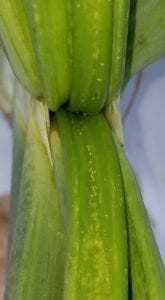Here are our weekly observations from the fields and farms around Wayne County from the week of July 11-15.
Vegetable Crops
Probably the biggest development in our area was the presence of cucurbit downy mildew on a path of cucumbers in southern Wayne County. This means there are active infections in Wayne and Medina counties, and likely the surrounding counties. Ideal conditions for continued progression and infection will exist in the coming days. It is important to take steps now to protect your cucumbers and cantaloupes.
Powdery mildew on cucurbits continued to spread rapidly, spurned on by several foggy mornings in the area.
As early plantings of summer squash and other cucurbits are harvested, it is important to practice good sanitation in the fields. Do not allow these areas to become diseased and insect infested, as they will only lead to problems in other areas on your farm. Once you are done harvesting an area, it is best to terminate the crop and either incorporate or remove the residue. 2
Other disease concerns revolved around bacterial diseases on peppers and tomatoes. We started to find some bacterial spot/speck on these crops.
Insect wise, it was an active week. Cole crops are still facing significant pressure from flea beetles and imported cabbage worm. European corn borer was identified in a few pepper plantings. Cucurbit crops saw increased activity from cucumber beetles, squash bug and squash vine borer.
Small Fruit and Orchards
A few diseases like scab and blister spot have started to show up on leaves in apples orchards, otherwise, the majority of any disease pressure has subsided after dealing with several rounds of fire blight outbreaks. Insect pressure in apples has slowed some as codling presence has remained low, however, some orchards are still facing some persistent damage from European red mites.
Some of our oriental fruit moth traps showed a significant flight, with some traps averaging nearly 30 moths per trap. Red mites were still active in the peach blocks as well this week.
The season is wrapping up for some of our raspberry growers, and blueberries won’t be far behind. With blackberries now coming into season, it is still important to be aware of the presence of the spotted wing drosophila, which are still being found in most of our traps. Japanese beetles may also be causing some troubles for small fruit grower, especially those with grape vines. We observed significant defoliation from Japanese beetles on grapes in several areas of the county this week.















